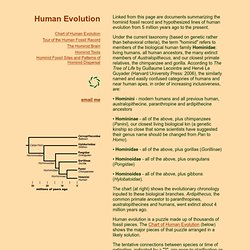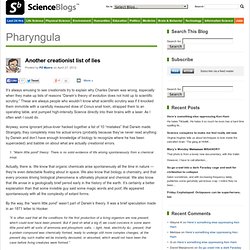

Paralysed rats 'learn to walk' 31 May 2012Last updated at 14:19 ET By James Gallagher Health and science reporter, BBC News Rat takes a step while spinal cord is stimulated Paralysed rats have been able to walk again after their spinal cords were bathed in chemicals and zapped with electricity, scientists have shown.

An injury to the spinal cord stops the brain controlling the body. The study, in the journal Science, showed injured rats could even learn to sprint with spinal stimulation. Experts said it was an "exceptional study" and that restoring function after paralysis "can no longer be dismissed as a pipedream". Ancestral Lines.
Evolutionary biologists use a cladogram, the treelike diagram of evolutionary branches or clades, to organize species into lines of evolutionary descent across time.

Biologists use three types of evidence to deduce evolutionary connections: genetics, morphology, and geologic dating. (Behavior, normally a key part of evolutionary studies, can only be inferred in extinct species — for example, by examining the ecology in which the species flourished and the species adaptations for eating and locomotion.) Analyses of primate fossils and the genetic relatedness of living primates converge to the conclusion that humans and chimpanzees branched from a common ancestor about 7 million years ago. DNA recovered from several uncontaminated Neanderthalensis fossils indicated that modern humans and extinct neanderthals diverged about 400,000 years ago; but more recent studies show that they must have interbred within Europe or the Middle East since then. Swiss Scientists Rewire Injured Spinal Cords, Paralyzed Rats Walk Again. Here at GeekTech, we've seen lots of contraptions to help the disabled regain some of their mobility.

Now, a group of Swiss scientists from the École Polytechnique Fédérale de Lausanne (EPFL) have found a way to rewire the spinal cord of rats after a paralyzing injury. This rat (pictured above) was just paralyzed a few weeks prior and is now running on a treadmill. The team accomplished this impressive medical feat with an extensive treatment of electro-chemical therapy and training with the help of a robotic harness. The treatment starts with a round of injections that contain a chemical solution of monoamine agonists to rouse the dormant spinal cord nerves.
These chemicals are used to replace the neurotransmitters (dopamine, adrenaline, and serotonin receptors) that normally triggered the brainstem. Once the chemicals have excited the spinal cord neurons, the scientists start electrically stimulating the spinal cord with implanted electrodes. [EPFL via Popular Science] Darwin Pond.
Piezoelectric speaker will let researchers talk with dolphins. A team of Japanese researchers from the Tokyo University of Marine Science and Technology may become the first people to communicate with dolphins using their own language.

Scientists create 'artificial life' - Americas. Scientists, for the first time, have created an organism controlled by man-made DNA.

Craig Venter, an American biologist, announced at a press conference on Thursday that he had synthesised an artificial strain of DNA and used it to take control of a cell. "[It's] the first self-replicating species we've had on the planet whose parent is a computer," Venter said. "This is a philosophical advance as much as a technical one. " Venter and his colleagues modified the DNA of a Mycoplasma, a kind of bacteria, creating a final strand composed of roughly one million "base pairs," the components which make up DNA. The human genome, by comparison, contains more than three billion base pairs. The scientists then injected the synthetic DNA into another Mycoplasma bacterium, which had already had its DNA removed. Inner Life of The Cell. Another creationist list of lies : Pharyngula.
It’s always amusing to see creationists try to explain why Charles Darwin was wrong, especially when they make up lists of reasons “Darwin’s theory of evolution does not hold up to scientific scrutiny.”

These are always people who wouldn’t know what scientific scrutiny was if it knocked them immobile with a carefully measured dose of Conus snail toxin, strapped them to an operating table, and pumped high-intensity Science directly into their brains with a laser. As I often wish I could do. Anyway, some ignorant jebus-lover hacked together a list of 10 “mistakes” that Darwin made.
Strangely, they completely miss his actual errors (probably because they’ve never read anything by Darwin and don’t have enough knowledge of biology to recognize where he has been superceded) and babble on about what are actually creationist errors. 1. Cancer.png (PNG Image, 600x3149 pixels) - Scaled (20%) The Disappearing Male. Scientists make cancer cells vanish. Custom byline text: EXCLUSIVE: Helen Puttick, Health Correspondent The system, developed at Strathclyde and Glasgow universities, is being hailed as a breakthrough because it appears to eradicate tumours without causing harmful side-effects.

A leading medical journal has described the results so far as remarkable, while Cancer Research UK said they were encouraging. Dr Christine Dufes, a lecturer at the Strathclyde Institute of Pharmacy and Biomedical Sciences and leader of the research, said: “The tumours were completely gone within 10 days. It is fantastic. Researchers around the world are trying to find ways to use genes as a cancer treatment, but one problem is ensuring they attack the tumour without destroying healthy tissue. In laboratory experiments the Strathclyde research team used a plasma protein called transferrin, which carries iron through the blood, to deliver the therapeutic DNA to the right spot.